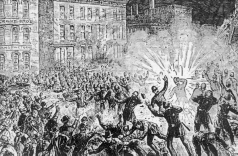V. The Founding of Fort Sheridan
In the 1870s and 1880s, the City of Chicago suffered from labor unrest that ultimately led to the establish-ment of Fort Sheridan. The turmoil that continuously flared up between labor and management climaxed in the infamous Haymarket Riots of May 1886. Members of a labor party had assembled at Haymarket Square in Chicago to air their grievances. When a local police-man threatened to use force to disband the crowd, the meeting disintegrated into a riot. A bomb was thrown into the crowd; seven people were killed and at least sixty-five people were wounded. Troops from Fort Leavenworth, Kansas, were summoned to quell the uprising, but further riots, such as those at the McCormick Reaper Works, continued throughout the year, resulting in uneasiness among Chicago’s promi-nent industrialists.
The effectiveness of U.S. troops in controlling matters
after the 1871 fire and the mob action following labor-management disputes
left an impression on Chicago business leaders. Prominent businessmen
and politicians, including George Pullman, Marshall Field, and Senator
C. B. Farwell, pressed for the establishment of a permanent military presence
in Chicago. In a meeting of the Commercial Club of Chicago in 1886, at
which General Sheridan was present, Marshall Field delivered an address
defining plans for such an installa-tion, and in June of that year, three
members of the club petitioned the Secretary of War to select land in
the vicinity of Chicago for a military installation. The official reason,
however, was not to squelch an unruly work force, but to establish an
"artillery school and military station" in the area.

Haymarket riot
From Michael J. Schaack, Anarchy and Anarchists, 1889
The War Department accepted the proposal to build a military installation and by July a team of officers, which included General Sheridan, had selected a location known as the Highwood Tract for recommen-dation to the Secretary of War. This 632-acre site was secured by the Commercial Club, donated to the government and accepted by joint Congressional resolution, dated March 3, 1887. John A. Logan, chairman of the Military Affairs Committee, sponsored the resolution, taking pains to assure his opponents that the acreage was truly a gift and that the army was requesting no additional appropriation.8 The deed for the property was signed October 6, 1887.9 Legally, the Commercial Club could neither own nor donate real property and, in fact, the Commercial Club of Chicago is not mentioned in the deed.10 A Commercial Club consortium of Adolphus C. Bartlett, Charles L. Hutchinson, and John J. Janes and their wives acted as intermediaries and served as grantors named in the deed. Subsequently, three ravines were named after these three members of the club. The realty consider-ation amounted to $10, 11 although Congressional records indicate that the club actually paid $300,000 in cash for the land.12 The post was called the "Camp at Highwood."
The first regiment arrived on November 8, 1887, which is recognized as the date the post was established. Eighty-four men commanded by Major William Lyster came from Fort Douglas, Utah. Timing was such that Lyster’s troops arrived at Fort Sheridan three days before the execution of the accused Haymarket Riot anarchists. In addition to Lyster’s men, 1,200 members of the Illinois National Guard were on placed on alert. The Haymarket crisis, however, passed without Lyster’s having to lead his men into Chicago.
On February 27, 1888, the Camp at Highwood was officially named Fort Sheridan after the general who had played such a significant role in the founding of the Fort. An order was received from the War Department signed by William C. Endicott, Secretary of War, stating, "By direction of the President the new military post at Highwood, near Chicago, Illinois, now called Camp at Highwood, will hereafter be known and designated as ‘Fort Sheridan,’ in honor of Lieutenant General Philip Henry Sheridan, U.S. Army." The order was issued by the Adjutant General, By command of Lieutenant General Sheridan. General Sheridan visited the post on May 5, 1888, and received his last review of troops. He died August 5, 1888.
Send any Fort-related news update information to mrtollfree@aol.com

